by Tom Gaylord
Writing as B.B. Pelletier

HW35 Luxus
This report covers:
- Disassembly
- Rekord trigger
- End cap comes out
- Mainspring and guide come out
- Piston is next
- Assembly
- The safety
- Back together
- What’s next?
Today, we’ll look inside the HW 35 Luxus to see what we find. I’ve thought from the beginning that this is a tuned air rifle, and I’ve given you the clues why. The baseblock is lubricated with some heavy grease that Weihrauch never used, and the safety seems to be defeated.
I also want to find out what material the piston seal is made of. If it’s leather, it needs more frequent lubrication than a synthetic seal would need.
Disassembly
Disassembling most Weihrauch air rifles is easy. Only the R9/HW95 and the new HW50 have those 4 tabs that hold the very thin end cap in the rifle and are a little harder to deal with. But this HW 35 is an old-school Weihrauch that has a threaded end cap.
I loosened three screws, and the barreled action came out of the stock. And I immediately know that my rifle has been tuned. I can see black tar on the mainspring — something only a tuner would ever put there.
Rekord trigger
The Rekord trigger comes out first after driving out the 2 pins that hold it inside the end cap. Once it’s out, there’s more evidence of a tune — there’s moly grease on the sear hook that grabs and holds the piston when the rifle is cocked. The other end of the sear, which is blocked by the trigger, is also coated with moly.
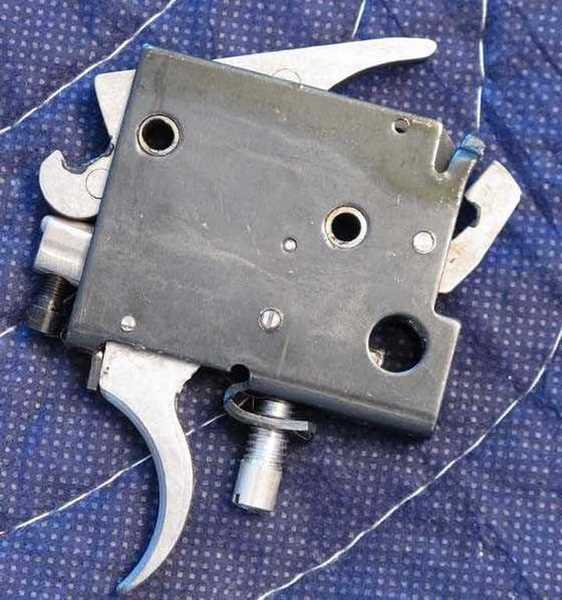
The Rekord trigger looks normal from the side.
But this Rekord trigger is different than others I’ve seen. The piston hook is made from three thin steel plates sandwiched together — very much in the same way that BSF made their triggers.
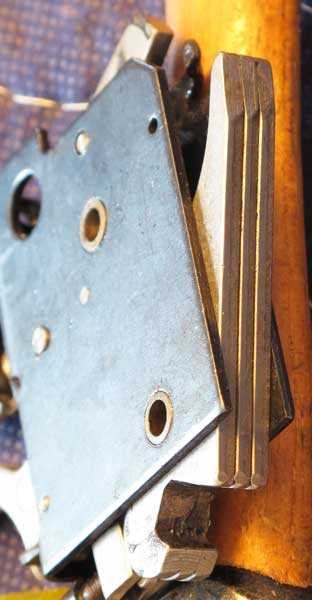
This view of the trigger shows three steel plates sandwiched together to form the piston hook. In later Weihrauchs, this part was made from a single piece of steel.
End cap comes out
Next, the end cap is unscrewed. On some rifles, this cap needs a start. I’ve found that the rounded end of a crescent wrench in the slot where the trigger fits provides a good lever. The rounded edges of the wrench don’t hurt the sharp edges of the trigger slot in the end cap.
You always want to put your barreled action in a mainspring compressor to remove the end cap, because you don’t know how much compression the mainspring is under. On this rifle, there’s an additional 1-1/2 inches of spring movement after the end cap separates, before all tension is off the mainspring. The mainspring compressor allows you to handle the parts without any strain.
Mainspring and guide come out
Once the end cap is off, the mainspring and spring guide can be pulled out of the spring tube. I was wearing gloves because this mainspring is heavily coated inside and out with an extremely tacky black tar. I wish I knew what this stuff is, because it very much resembles the stuff Ivan Hancock used to put on the Mag 80 Laza springs for his special tuning kit. It’s thicker and tackier than any material I’ve been able to find.
When I tugged on the Weihrauch factory spring guide, it didn’t move. I think the mainspring fits the guide very tightly, but that black tar grease is certainly helping. I handled these parts very carefully, because I didn’t want too much of that stuff to rub off. I didn’t have anything as nice to replace it.
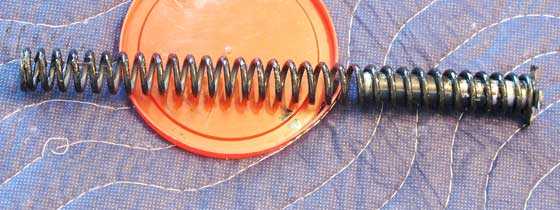
The mainspring is coated with a special black tar grease inside and out. The factory spring guide fits the spring very tight.
The spring is straight. It looks good to go for the next 10,000 shots at least.
Piston is next
The piston comes out next. It’s connected to the barrel by the cocking link, so the barrel has to come out of the action forks at this time. On a Weihrauch, this is very easy to do. First, remove the pivot bolt nut on the right side of the gun. Then, the pivot bolt can be loosened and taken out. Once it’s out, the barrel slides out of the action fork, and you can unlatch the cocking link from the piston.
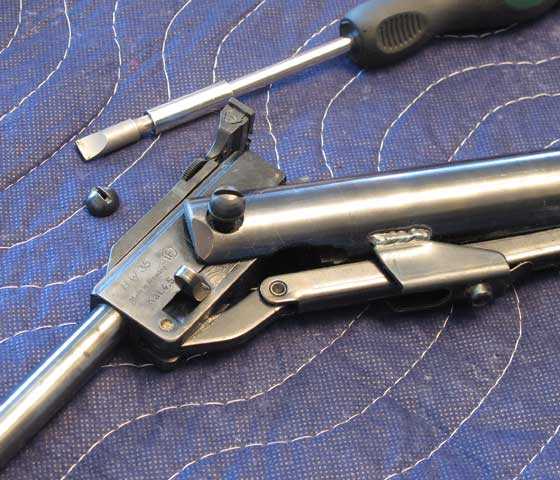
Now, the pivot bolt comes out so the barrel can be separated from the spring tube. Then, the cocking link can be detached from the piston, and the piston can be removed. Notice that the cocking link is two-piece.
When I did this, I noticed that the baseblock and pivot bolt were coated with the same black tar that was on the mainspring. Either this tuner knows something I don’t, or he’s using the black tar like a hammer and sees every part of the airgun as a nail. What I mean is that you don’t use black tar to lubricate metal-to-metal parts, though that’s the original purpose of the product. I use moly on these parts because it lubricates better and lasts longer.
I also note that he used moly on the front and back of the piston, which is exactly correct. So, maybe he knows something I don’t.
The piston seal is leather, which is what I’d hoped. It appears to be in perfect condition and should outlast me if I keep it well-oiled.
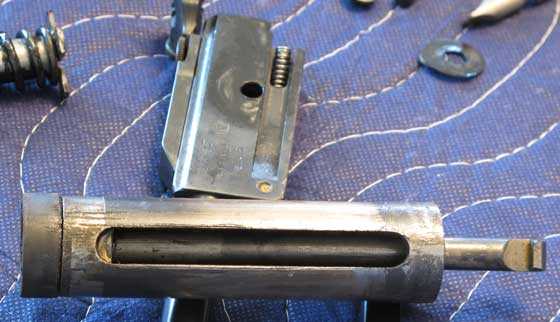
The piston is coated with moly front and rear — exactly as it should be.
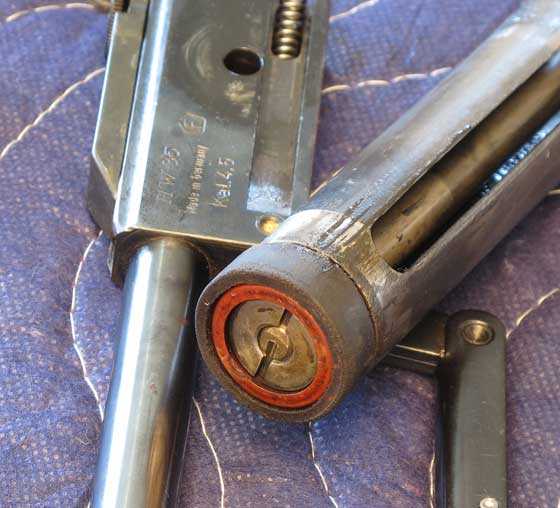
The piston seal is leather, like I’d hoped.
Assembly
Following this examination of all the parts, I put the rifle together, again. I lubricated the pivot bolt and both sides of the baseblock with moly, but I didn’t bother removing the black tar grease. I figured the former tuner might have been onto something.
As I put the nut back on the pivot bolt, I noticed another anachronism. The lockwasher for the nut is a split wire washer instead of a conventional flat lockwasher. Weihrauch was still using conventional flat lockwashers in 1994, when I purchased the R1 about which I wrote the book, so this 1979 HW 35 should certainly have one. This is another clue that someone has been inside the rifle, because they used parts that weren’t around when the gun was new.
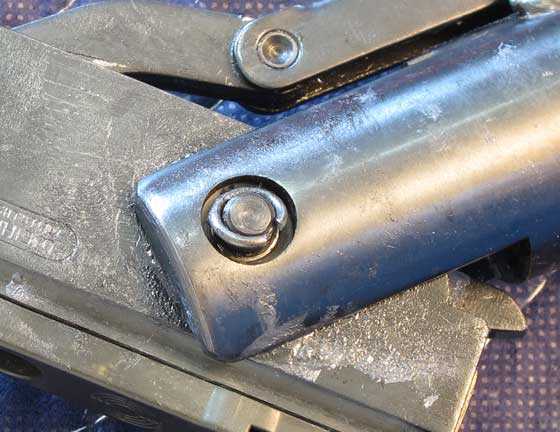
The lockwasher for the pivot bolt nut is a split wire lockwasher instead of the split flat lockwasher it should be.
The safety
As you recall, I mentioned that I would like to return the safety to functioning status when I took the rifle apart. I examined it and saw that there’s no spring to operate the pin. Also, the pin appears to be crimped in place on close examination.
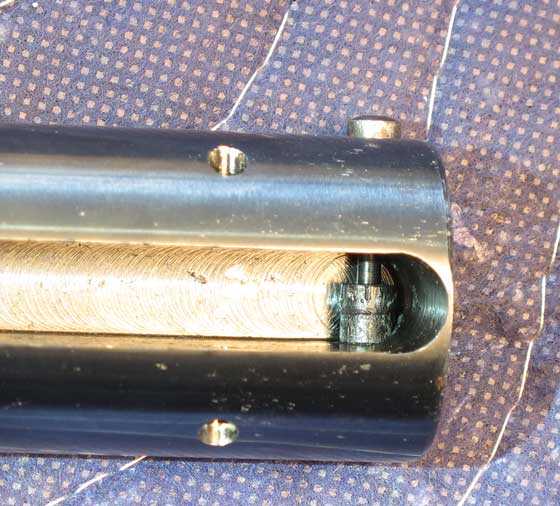
Looking into the trigger slot in the end cap, the safety pin has no return spring. It also looks to be lightly crimped in place.
I decided to leave the safety the way it is for now. I don’t have any experience with this version of Weihrauch safety and would rather understand it better before I do anything.
Back together
I put the rifle back together and noted that the whole job took about one hour, start to finish. That included time for photography. Weihrauchs are so straightforward!
After the rifle was back in the stock, I oiled the piston seal with about 10 drops of silicone oil through the air transfer port. I then uncocked it, which you can do with this model because there’s no anti-beartrap device. I let it stand on its butt for an hour before I cocked and loaded it with one pellet. I fired it, just to see if the action was still as smooth and calm as before. A little oil came out the muzzle; but the next morning, another shot produced no more oil. The seal is now saturated.
What’s next?
Next, I guess I’ll mount a scope on the rifle and shoot it at 25 yards again. Several readers asked me to do this.
This rifle is a big drooper. You can actually see the angle of the barrel relative to the spring tube, so I’ll have to mount something to compensate for that.
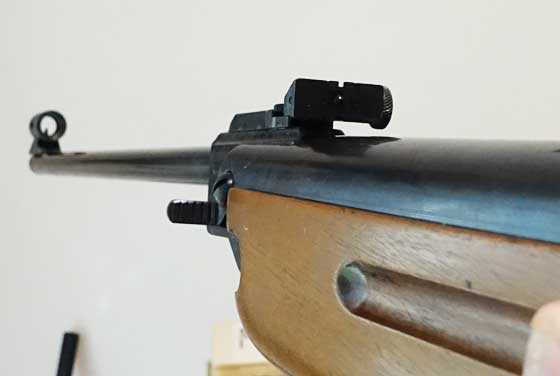
When the barrel droop is this visible, it’s going to be excessive.
When I get things set up, I’ll run the accuracy test with a scope.

What is it with German rifles of this era and droop!, I have a pet theory to do with the angle of the cheekpiece, sloping towards the rear, you see it a lot in old gallery guns, they look like they have a fold in the rifle!, it’s definitely engineered in, for some traditional reason to do with hold and open sights.
Also, at what point does a mechanically sympathetic farmer who only has a tub of open gear lube or CV grease to hand…..become a tuner, this gun has been stripped and greased up…that is all, not tuned…all parts are as factory spec, a pot of a fairly common grease does not a tuner make, if it does, then SFS, Airguntech and Vortek et al can hang up “Gone Fishing” in the store window.
Though I’ve seen plenty of the single sided safeties….a proportion of which, like yours are not functioning, I must say, not a clue about the mechanics of it either….must be something on the interweb…though if something is broken I suspect parts might be a challenge
My 82 HW35 has the multi leaf thing going on too (double sided safety though)
BB And Fellow Air-gunners
Thank you for the detailed look and comparison of the inside workings of your HW35 Luxus. I agree Weihrauchs are a very easy air rifle to work on. Much easier then my Norica Model 61 in.22cal. Just tonight, I finished putting in a V-Mack spring kit on a friends HW77. As you indicate, it took me about an hour from start to finish. However, I wasn’t hampered by taking pictures for documentation. I to favour the threaded trigger block found on the older Weihrauchs as well as the newer HW77/97, HW80, and HW35E models. However, I have had no problems with the slotted rear air tube and the 4 tabs found on end cap of the HW50,85,95,98 models. I have zero experience with the HW30, or HW57, so I decline to comment on these models. I do think the 4 safety tabs are typical German over kill, as 2 would be plenty in my opinion. Especially when you consider the Chinese made spring piston rifles typically have just 1 pin behind the mainspring.
It’s also nice to see you have a leather piston seal in pristine condition. It just proves, with proper lubrication, leather will last as long as any synthetic seal. Apart from the trigger hook made from three laminated pieces, I also notice what looks to be a proper adjustment screw in front of the trigger. It’s hard to make out much detail with my failing eyesight. All my Weihrauch’s have just a small grub screw in that location that a wise old Weihrauch owner cautioned me never to touch.
The barrel droop is as much as I have seen on any airgun save for an old model Slavia from my youth, circa 1960. A friend who was it’s owner, was so disturbed by his “bent barrel”, proceeded to make it worse by trying to straighten it in his Father’s vice. In the end, he still had the droop, and because he failed to protect the barrel from the vice jaws, had a few permanent and unsightly marks as well. It never occurred to us the rifle was a straight shooter because both the front and rear sights were both located on the barrel. Scopes were something one dreamed of owning back then. I can’t remember if the Slavia had any provisions for mounting a scope at all. It should be interesting to see just how much compensation you will need to get your HW35 Luxus on paper at 20 meters.
Ciao
Titus
BB,
Maybe you should try one of these out on that HW35 to deal with that droop. I am using the short one now and plan on getting the long one soon. You have go pretty far to out droop these things, plus you have the ability to use Weaver/Picatinny mounts.
/product/hawke-sport-optics-1-pc-elevation-adapter-3-8-to-weaver-rail?a=4163
/product/hawke-sport-optics-9mm-11mm-dovetail-to-weaver-rail-7-2?a=5065
RR,
Thanks for the links. I didn’t know about those bases.
B.B.
I believe I sent you one of those bases awhile back. Even modified a vertical stop pin for a gun you were testing that wouldn’t keep mounts in place. Didn’t work because the hole that looked like it was designed for a stop pin wasn’t a hole designed for a stop pin. Don’t remember the model of the gun.
kevin
Kevin,
Thanks for reminding me. I’ll look for it.
B.B.
The gun was the cometa fusion you were doing a series on back in January 2013 if that helps.
kevin
B.B.,
Nice article. Since having the TX down, the mechanics of tearing down an air rifle has taken on a new meaning. I was surprised to see the laminated steel on the piston hook as I thought this was used later, and not earlier, in mfg. in general.
If that droop picture does not show what droop is, I do not know what would. Holy cow ! Can even minor droop be seen like this, like on a new Diana or even a cheaper break barrel ? Good picture.
Do you know if the nipple that holds the breech seals on a TX compression chamber is removable? It has a flat side on the otherwise cylinderical nipple. No doubt, a special socket would be reqd. if so. This is basically a transfer port, but not sure if it goes all the through, or bottoms out. If not, then the back of the big nut on the front of the compression chamber would act as the primary transfer port.
And while we are at this specific area, do you know of any tunes that ever messed with the transfer port on a TX?
Thanks, Chris
Chris,
I’m sorry, but I don’t know about removing the TX “nipple” as you call it.
And I never heard of a tune that modifies the TX transfer port. I believe Air Arms got that one right on the first try.
B.B.
As a kid I used to chamfer/polish the piston-side of the transfer port (about 1/16″ radius) as part of my tuning process.
Didn’t increase the exit diameter of the port, just created a bit of a venturi to (theoretically) reduce air flow turbulence over the sharp edge of the hole.
This was part of the cleanup/deburr/lubricate tune-up I did after the rifle and seen a couple of cans of pellets so I could never determine what affect this specific operation had on the performance. Didn’t have any way of measuring something like that anyway. Overall the tune-up would result in a noticeable increase in velocity and a much smoother firing cycle.
Haven’t done that in years.
Vana2
Vana,
Nice tune tip. Makes sense in a “theroretical” sense ! Should work. I would like to see some thoughts on modifying transfer port ID’s as part of a tune.
Been meaning to mail you. Sorry. Working on getting the TX down to 1/2″ at 25 yds. GF can update if your interested. Figured I better get that down before going to the “Dark Side”….. 😉
That S510 is sweet. Recent review, etc. Thinking Mrod for first, plus gear and Hatsan 44 or 65 OR 510 second. Oh god,….I’m hooked !!! 🙂
Chris
Chris,
You are now starting to understand why we call it the Dark Side… it sneaks up on you and then you are hooked! LOL!!
.25 caliber Mrod eh? Good start.
I just missed out on a deal for a .22 FAC HW100 by an hour – would have been nice to keep my .177 company.
Vana2
B.B.,
You have that rifle that changes ports. Sorry, without consulting my notes, I forgot the model. Bigger port = more power.
Next time you have a TX down, or, replace the breech seal(s), check it out.
Just asking and always curious as to what does what.
Thanks, Chris
Chris,
about all I’ve found on TP mods is that my QB-36 could benefit fom a smaller one so I’ve considered pressing in a sleeve. But it’s a long way through the spring tube from one end to the other!
Chris,
Close.
Bigger port = LESS power!!!
I found in the R1 with the changeable ports that 0.125″ was ideal.
B.B.
Chris,
YouTube has several tx disassembly vids. You might wanna watch them.
Dutchjozef,
Seen quite a few,….none that address the transfer port. I have a .22 and thought the transfer port might have a different I.D. than a .177.
Chris
Chris, USA
Why do you want yo modify the transfer port hole for?
GF,
Just asking,..that’s all. I forgot the model that BB has that changes transfer ports. If it works on that, then why not the TX? Of course, parts would have to interchange.
I would think that a .22 might have diff. guts than a .177,….but from what I have read, only the barrel changes.
Mmmmm?
Chris
Chris, USA
I think that gun is the Wiscombe if I’m spelling it right. And if I remember right that is a pcp gun. But it might be a spring gun. To many guns in NY mind to remember without searching to find out.
If your opening the transfer port hole on a pcp gun you are usually opening a passage to the barrel and its behind the pellet and usually on the bottom of the barrel. Well most pcp guns. The AirForce guns are in line with the barrel so they are probably more efficient at how they use air.
On a spring gun the transfer port is usually inline withe the barrel bore.
Here’s something to think about. What would happen if the transfer port hole was bigger than the skirt diameter on the pellet on a spring gun? How will it change the air flow when the air hits the back of the pellet? What point would a bigger diameter than the factory diameter be to much and it actually doesn’t flow as good from bumping into a flat surface rather than flowing straight to the back of the pellet. Then you have to think about how or if it would change the shot cycle because of the cushion of air that the piston stops on before the pellet moves could change.
A pcp gun you don’t need to worry about a piston coming to a stop or if the transfer port hole is matching the skirt diameter or should I say smaller than the skirt diameter. You have a plastic of air suddenly hitting the pellet. A spring gun has a gradual build up of air compared to a pcp gun.
A transfer port hole is just another part of the system and everything has a balancpoint. To much can be no good as well as not enough could be not good. Then throw in barrel bore size to pellet fit. Then barrel legnth.
And from what I understand is that most spring guns do use the same insides for all the calibers.
Suppose to say you have a sudden blast of air not plastic.
And farther down should be everything has a balance point.
GF,
Yes, Wiscombe,…Thank you. All good points you made. I am 99.9% sure the Wiscombe is a springer.
And yes, how much is too much ? That is why I am asking. Maybe no one has “played” with this yet on a TX?
Several diff. front nuts, ( on the comp. chamber ), and some drill bits, and a chrony, and it would tell all. With the Wiscombe, at the time, I would think that a lot of tuners were trying modding the transfer port ID’s in an effort to copy.
Just a guess and just curious.
Chris
Chris, USA
I believe that on a spring gun messing with making the transfer port diameter wouldn’t really give you that big of a increase.
Let’s say on a spring gun it increased the velocity of the gun 50 fps. How much fpe did you pick up?
A springer shooting a 16 grn pellet at 630 fps would be making around 14 fpe. Then with the extra 50 fps would be 680 with the 16 grn pellet. That spring gun would then make 16 fpe. So that only increased your gun by 2 fpe.
I guess if you were looking for every little bit out of the gun then it would be worth something to that person. Otherwise it does make for a good conversation.
Forgive me for butting in, but that would be just over a 14% increase in fpe. Not insignificant, I would say.
Jim
Don’t worry about butting in.
Maybe somebody would want to do it to pick up the extra energy but I wouldn’t.
I would posably radius the sharp edges like Vana2 mentioned. And maybe try to make the transfer port hole on a spring gun match the inner skirt diameter of the pellet or maybe just a little smaller.
That way the airflow would concentrate on pushing and expanding the skirt for a better bore seal.
That would be the biggest I would go with the transfer port hole on a spring or nitro piston gun.
Chris,
At one time B.B also. had a gun modified to accept different transfer ports by one of the premier tuners out there.
I wish I could remember more about it because it was a very interesting series.
Try using the search box with transfer ports.
or Maybe someone else will remember. when they see this.
Good luck!
Reb
Reb,
That was a Beeman R1 that Dennis Quackenbush modified for me. It’s in the R1 book and also here:
/blog/2010/02/changeable-air-transfer-ports/
B.B.
Thanks B.B!
I was pretty sure it was Dennis that threaded the breech and made the transfer ports but I knew someone would remember more about it and just wanted to get Gove Chris the chance to read it before attempting the same.
BB,
I have got a HW 35 (nr 710864, 0.22″) which also has the barrel droop (around 2 degrees) and shoots all over the place with its standard sights (1 inch groups at 5 mtrs!) . I will scope it and let you know the results of that.
To me it looks like the rear sight is not up to its job. It seems to move with every shot.
Regards,
August
August,
Thanks. The more data I get the more we will know about what can be done.
Your loose rear sight sounds like the reason so many people are installing a Weihrauch target rear sight. I checked my rear sight and it seems very tight.
B.B.
@BB:
That droop looks severe… I would have thought the fancy barrel lock would minimize it. It almost looks like an effect of the perspective or the camera’s lens.
It seems that neither my 2014 Diana 31 nor “my” 1980 HW35 have that much droop. I am using a cheap 4×32 scope with a shim under the rear ring and I could get it sighted in just fine on both rifles.
@fellow HW35 users: What are your serial numbers? The one I have here is an “E” model and I have deduced from the Dutch HW database that it should have been manufactured in 1980 (my year of birth :-). I didn’t register it, though, since it’s not mine…
If you’re interested I can post pictures and the serial number when I get home from work.
Any idea when Weihrauch made the switch to a synthetic piston seal?
Stephan
Stephan,
I showed the barrel droop because it is the most severe case I have in my gun collection. I may have seen other guns that were as bad, but this one is really pronounced.
Weihrauch switched to synthetic seals in the early ’80s. The HW80 came to market in ’81 or ’82 and had a synthetic seal. And I believe they made the switch my model, so some guns were still using leather while others had synthetics.
B.B.
Could the droop have to do with the thickness of the barrel seal?
On the 35 I have, it is quite flat and hard, barely sticking out of the base block at all. It still seems to do its job. My ultra-accurate splat test shows full (F) power 🙂
Stephan,
Yes, the HW35E serial number 847199 was manufactured in 1980.
Weihrauch serial number 843636 was the change from leather to nylon/synthetic piston seals.
Serial number 755000 was when Weihrauch changed from 13mm to 11mm dovetails for scope/rear diopter sight mounting.
We know 741394 was made in 1979 and 900160 was made in 1981.
Weihrauch serial number 1,000,000 was a special gold plated HW35 made in August 1983.
kevin
BB,
I have a question about the Rekord. I wonder if Weihrauch ever put a pin in the upper part of the cassette to hold the piston hook down? There are holes for the pin but I have never seen one put in from the factory. I do have a pro tuned rifle that has one and I have put one in some of my rifles. I can’t tell a difference though and I suppose that’s the reason HW omits it.
Mark N
Mark,
This is the first time I have heard mention of a pin.
B.B.
BB,
Well there are pins or axles in all the other holes in the side of the case that holds it all together. Only the upper pin is missing. It’s shown clearly in your picture. I just wondered if HW ever put a pin in there to hold down the latch. My PW tuned 35E has one but I have to think that PW put it there.
Mark N
Mark,
That hole is for working on the trigger or adjusting it, I think. A pin through it holds the sear hook down, so you can work i=on the sear and not fire the trigger.
B.B.
BB,
Thanks for the info but I think you would find that the trigger works perfectly with a pin holding the latch down. You could try with yours while it’s out. Just use a drill bit or similar.
I understand that having a pin there is not necessary for the function of the trigger. But Weihrauch put the holes there so I was just wondering if there were ever pins installed.
It’s really unimportant. I was just wondering.
Thanks again,
Mark N
Mark,
That was just a guess. I really don’t know. Maybe it helps with assembly.
B.B.
Mark, older examples of the Rekord do in fact have a pin across the top of the “box.” It serves to limit the upward swing of the big piston hook when it is released.
This does two things: 1) makes the trigger release a little quieter, since the hook isn’t smacking into the receiver tube; and 2) makes it easier to put the trigger module into the gun since you aren’t pushing against the hook’s spring.
Obviously, neither of these is too big a deal! So they just started omitting the little pin at some point.
On point 2, it’s easiest to put the trigger back in the gun if you cock the trigger first (by pushing down on the back of the hook), then you don’t have to push against its spring at all. But you have to remember to pull the trigger and release the hook before your subsequently cock the gun the first time.
Mike,
Thanks for weighing in on this. I learned something, too.
B.B.
B.B.
I believe that “Black Tar” is open gear grease. It is for open gear cases, originally for mining machinery.
You can buy a tube for around $5-6.
The Valvoline brand may also have moly in it. The tubes of this type grease many times say “sticky” on them.
Tom,
Yes, I am aware that black tar is open gear lube, but this brand is of particular interest. I just wish I knew what it is, because I would like to get some more.
B.B.
Do you know of where I can purchase a mainspring for a Walther LG 55?
James,
I think John Groenewold has them.
B.B.
Measure the ID, wire diameter and coil count, then go to the Vortek and Air Rifle Headquarters sites; you’ll find one that will work fine.
B.B.,
Off-topic, but pellet-shooting revolvers are so few, I’d be very appreciative of a report on the new Gamo PR-776.
I am especially interested not just because it is a rifled barrelled lead pellet shooter, but also because it employs what looks to be a new and inventive clip, kinda like a Crosman .357 but with the clip behind the cylinder and recessed into it so as to make it inconspicuous. Also, it IS a revolver, and revolvers are to me the coolest of handguns.
Thanks for any consideration you might show,
Michael
Michael,
I have that revolver laying on my desk. I was going to start my report next week.
B.B.
B.B.,
Thanks for the look inside your HW35.
I purchased a new Slavia 634 with plastic stock. It’s an interesting, inexpensive little rifle, with a few shortcomings.
1. The rifle has significant vibration on firing, and it isn’t improving with use. The spring and metal parts are well lubricated with grease. Would this rifle benefit from lubrication with black tar or another lubricant? Any easy, inexpensive fixes to reduce the spring noise and vibration?
2. The barrel pivot is appropriately tight, but the barrel has slight left-to-right looseness that did not correct itself after I further tightened the bolt. Might shims help? Where would I buy them?
3. The trigger is poor, but improving with use. I’ll just keeping shooting it and see how much more it improves before I try anything else.
Appreciate your thoughts,
RB
BR,
Reader Milan suggested a “beer-can” tune, in which an aluminum beer cap is cut into a shim for inside the piston. Use the right grease and he says it takes out all the vibration. Fold flaps of the shim on the piston-head side so the shim is held down by the spring.
B.B.
B.B,
This Slavia will be an interesting education. I’ll first try a simple polish and lubrication job to quiet the spring, and see if I can shim the barrel pivot to tighten the looseness. If that doesn’t work, I’ll try to shim the piston.
Good luck with your 35.
RB
RB,
Yes, shims will likely help tighten your wobble. This was a common problem with the slavia 633/631/634 airguns. Many folks countersunk the bolt hole and installed a delrin insert to correct the problem. Russ Best used to make and sell shims/washers for the slavia guns. Don’t know if he still does but might have a suggestion for where you could obtain them.
Thought you mind find this interesting:
https://sites.google.com/site/cherrytwist/slavia631tune-up
kevin
Kevin,
Thanks for your comments and the link. I’ll try to find shims that I can easily install to tighten the barrel pivot. One of the reasons I bought this rifle is because it is easy to work on, and it will be a learning opportunity for me.
Any thoughts on lubricants to quiet the spring?
Thanks,
RB
RB,
Heavy Tar if tolerances are loose and you’re shooting in a warm climate. Cold Weather Heavy Tar if you’re shooting in colder climate.
https://www.airrifleheadquarters.com/page/page/251484.htm
kevin
Kevin,
I reread the Slavia dis-assembly/lubrication/assembly link you sent me. Its very detailed, and I think I can do it. Thanks! This will be an interesting experience.
RB
Here are some pictures of the HW35 I have
Sorry for the bad quality. I used my phone and didn’t have the best lighting…
It’s an HW35E and has the serial number 847199. It was probably made around 1980. It’s an (F) model with 7.5 joules (175m/s; 575 feet/s).
I don’t think it has had maintenance yet and it still looks and shoots just great. There is pretty much no vibration at all, just a very solid “thwack” when you pull the trigger.
When I got it, the trigger was a bit “sticky” from old grease and couldn’t be adjusted as light as one would wish to because it released without pulling it. Some oil and repeated use has fixed that. The same goes for some noise during cocking.
Please don’t ask me to disassemble anything… It’s not mine (I wish it was 🙂
Stephan
Stephan,
What a gorgeous stock! It make’s Tom’s stock look like firewood in comparison.
Edith
Stephan,
That rifle is drop-dead gorgeous! I wish it were mine.
B.B.
Me too 🙂
Stephan,
Nice gun, the stock looks aftermarket and more in the style of the target rifles of that era. That sling mounting lug on the barrel was provided by Weirauch or is this an after sale addition? Do you have any idea why that was placed there?
Second, your rear sight is extremely to the right and down. Is that accidental or do you really need that to be able to use it?
Regards,
August
HW35E model.
CptKlotz,
2 words,…WOW and Drool ! Beautifull !!!
Chris
Dang! That’s a lovely rifle! Is the stock walnut or maple? My hw 35 is the Safari I recently acquired. It tuned up nicely with a macarri kit and generates 11.5 ft lbs. Dead calm firing sequence. I did seal the transfer port block with hot beeswax to overcome the voids in the manufacturing process. It has a wicked droop like Tom’s Luxus.
Mr Rob, BB’s HW 35 stock is European walnut. The warm pale color is very typical of this wood, which is a completely different species that the black walnut seen in the US.
To the best of my knowledge, no German-made airguns have ever had factory stocks made of maple.
MDriskill i was refering to the photos of CtpKlotz isnt that a nicestock? Without a doubt that is the most handsome factory stock on an HW I’ve ever seen.
My HW 35 has the holes in the Record for the pin you are refering to but no pin. Really do love my HW 35 they are my favorites.
Stephen,
What a beautiful HW35E you’re looking after.
Very common that those sling swivels were installed by the factory in those walnut stocks. That one has exceptional figure in the stock. Pretty sure that stock was OEM.
Never saw a rear sight like that though.
Weihrauch offered the so-called “Export” stock (HW 35 E), with the more curved “American-style” cheekpiece, a flat-bottom pistol grip with a plastic cap, and white spacers at the buttplate and grip cap. This gun usually also has a longer 22″ barrel, though Beeman’s imports had the standard 19″ barrel and were called “HW 35 EB.”
I’ve seen quite a few HW35E models that were “held back” and therefor limited to 7.5 joules.
kevin
Nice wood. Pretty rifle.
No missing that droop. They haven’t just drilled the barrel at a downward angle. The whole barrel is pointed downward. My only guess at the reason for this is that in the times before magnum air rifles, the shooting distances were extremely short. So airguns that had the proportions of firearms were quite unsuited for sighting in at the short distances they were used for. When I re-zeroed a scope from my indoor range to 25 yards, I had to go down about 95 clicks. My indoor range is extremely short, but I think the example is still relevant. So, maybe the Germans drooped barrels to make the sighting solutions easier.
Matt61
Edith,
interesting isn’t it? You’d expect the “Luxus” (=luxury) to be top of the line, but maybe this one is. “Export” is kind of a nondescript name and might also lead you to think it has the stronger spring (commonly called “export springs” here) even though it’s a regular (F) version.
It’s possible that this one hasn’t seen much use. It belongs to a friend of a friend who doesn’t want to have it in the house because of the kids. It’s in my care for now and I can play with it 🙂
Stephan,
First….”your” 35 is a very good looking rifle, talk to your friends friend and ask how much he wants for it!!!
Second, my german gunsmith told me the “E” doesnt mean Export.
I think he said it means Extra.
Jozef,
I know many dealers list the “E” as “Export”. I just assumed that was the meaning.
Extra would make more sense I suppose, because you get some extra features.
Stephan
Stephan, you are right. Almost all the dutch dealers label them as Export. Even in germany they do. It only takes a few dealers to write Export….. and we all subsequently think it IS Export.
Stephan,
Nice gun, the stock looks aftermarket and more in the style of the target rifles of that era. That sling mounting lug on the barrel was provided by Weirauch or is this an after sale addition? Do you have any idea why that was placed there?
Second, your rear sight is extremely to the right and down. Is that accidental or do you really need that to be able to use it?
Regards,
August
August,
no idea about the rear sight. I adjusted it so I hit stuff 🙂
I don’t have another Weihrauch for comparison except for my HW45 which has a different type of sight.
The front sight has a dent in it, so maybe something is bent.
Stephan
Stephan,
I should have looked first on the Internet instead of asking. This E version had this type of stock and that lug. Whether that is handy on an airgun I still do not know.
Regards,
August
L.S,
Off topic.
I found a advertisement for a Diana 65 smootbore target gun. Does anyone know of their existence? It seems such a waste to couple a smootbore to the Giss system.
Regards,
August
August,
That is a contradiction in terms. A smoothbore cannot also be a target gun. Not for paper targets. Maybe for clay pigeons.
Is that advertisement a commercial one, or is it someone advertising one gun for sale? I wonder how they know it is a smoothbore? Some people can’t see the rifling in airgun barrels.
B.B.
AB,
A private sale. As to the bore, I thought the same, but we will see. I took the plunge and bought it. as it was going for half the price these guns normally go. So iís a good deal whether it is a rifled or a smootbore one. I will keep you informed.
Regards,
August
August,
That was a no-brainer. If it is a smoothbore, it is very unique. And if it is rifled, you have a fine target rifle.
I will be interested to learn which it is.
B.B.
August, some European countries have had regulations forbidding rifled-barrel airguns. I know this was true in Ireland for some time after WW2. I have seen smoothbore Webley Mk 3 underlevers intended for the Irish market, for example.
So it’s possible that smoothbore Diana 65’s were made, though I certainly agree wth BB that it much have been a bit of a compromise performance-wise!
No one asked yet so I will; What are the spring specs for this F model? Wire thickness, ID, Coil count etc. I also have a 1979 35, but it has a walnut stock that is a twin in style to the Goudy design. Stock spring was .142″ wire, but it was worn, so I put in a JM spring that he sells for his kit. My leather seal was great, but the gun shoots smoother with a synthetic conversion. Thanks
BB, a couple notes on older HW rifles:
1. The sear hook built up from multiple plates was used prior to the solid one-piece one (the oldest Rekord I own actually has it made from a rather precarious-looking single thin plate!). I have a hunch that the change to a solid hook was made in the late 70’s, to accommodate the extra power of the HW 80/R1 family…but that’s just a hunch!
2. The wire-type lock washer under the breech bolt locknut is also frequently seen on these older Weihrauchs.
3. I also notice your gun has no chafing washers beside the breech block, a detail that began to be added in the mid-70’s. I often add those to older guns when I rebuild them, to help preserve the blueing on the sides of the breech, but it’s not strictly necessary of course. Many old barrel-cockers do just fine without them!
Finally…the barrel droop on the gun seems truly excessive! Have you tried trimming (or just replacing) the breech seal to fix that?
Mike,
All good to know.
I do have one washer on the side opposite the barrel latch.
B.B.